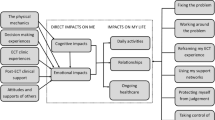Abstract
Differentiating between epilepsy and psychogenic non-epileptic events (PNEE) can be difficult given similar presentations. PNEE is often misdiagnosed, resulting in unwarranted treatment with anti-epileptic drugs (AED). While the gold standard for differentiating PNEE from epilepsy is video EEG (VEGG) monitoring, self-reported symptomology has also been shown to discriminate between epilepsy and PNEE with high accuracy, particularly in cases where VEEG is difficult to obtain or when there are no observed events during extended monitoring. The Patient Competency Rating Scale (PCRS) was developed to measure the extent to which individuals are able to function in four domains: activities of daily living, emotional, interpersonal, and cognitive competency. Factor analyses validated the underlying factor structure of the PCRS in this seizure disorder sample. Follow-up MANOVA revealed group differences such that those diagnosed with PNEE reported less competence in all areas of functioning as compared to those diagnosed with epilepsy, with the largest difference being emotional competency. Secondary factor analyses were conducted for each diagnostic category. Two items related strongly to emotional competency loaded equally across the factors for those diagnosed with PNEE, indicating that emotional control is highly correlated with all areas of perceived competence for those with PNEE in this sample and may be considered as an intervention target. This was the first study to validate the use of the PCRS for a seizure disorder sample and to examine group differences in self-reported competency between those diagnosed with epilepsy and PNEE.
Similar content being viewed by others
References
Barskova T, Wilz G (2006) Psychosocial functioning after stroke: psychometric properties of the patient competency rating scale. Brain Inj 20(13–14):1431–1437
Baslet G, Prensky E (2013) Initial treatment retention in psychogenic non-epileptic seizures. J Neuropsychiatr Clin Neurosci 25(1):63–67. https://doi.org/10.1176/appi.neuropsych.11090223
Benbadis S (2009) The differential diagnosis of epilepsy: a critical review. Epilepsy Behav 15(1):15–21. https://doi.org/10.1016/j.yebeh.2009.02.024
Benge JF, Wisdom NM, Collins RL, Franks R, Lemaire A, Chen DK (2012) Diagnostic utility of the structured inventory of malingered symptomatology for identifying psychogenic non-epileptic events. Epilepsy Behav 24(4):439–444. https://doi.org/10.1016/j.yebeh.2012.05.007
Borgaro SR, Prigatano GP (2003) Modification of the Patient Competency Rating Scale for use on an acute neurorehabilitation unit: the PCRS-NR. Brain Inj 17(10):847–853
Hall-Patch L, Brown R, House A, Howlett S, Kemp S, Lawton G, collaborators, N (2010) Acceptability and effectiveness of a strategy for the communication of the diagnosis of psychogenic nonepileptic seizures. Epilepsia 51(1):70–78. https://doi.org/10.1111/j.1528-1167.2009.02099.x
Krumholz A, Hopp J (2006) Psychogenic (nonepileptic) seizures. Semin Neurol 26(3):341–350. https://doi.org/10.1055/s-2006-945520
Lawton G, Mayor RJ, Howlett S, Reuber M (2009) Psychogenic nonepileptic seizures and health-related quality of life: the relationship with psychological distress and other physical symptoms. Epilepsy Behav 14(1):167–171. https://doi.org/10.1016/j.yebeh.2008.09.029
Lee GP (2010) Neuropsychology of epilepsy and epilepsy surgery. Oxford University Press, Oxford
Leidy NK, Elixhauser A, Vickrey B, Means E, Willian MK (1999) Seizure frequency and the health-related quality of life of adults with epilepsy. Neurology 53(1):162–166
Prigatano GP, Altman IM, O'brien KP (1990) Behavioral limitations that traumatic-brain-injured patients tend to underestimate. Clin Neuropsychol 4(2):163–176
Reuber M, Elger CE (2003) Psychogenic nonepileptic seizures: review and update. Epilepsy Behav 4(3):205–216
Sirven JI, Glosser DS (1998) Psychogenic nonepileptic seizures: theoretic and clinical considerations. Neuropsychiatry Neuropsychol Behav Neurol 11(4):225–235
Szaflarski JP, Hughes C, Szaflarski M, Ficker DM, Cahill WT, Li M, Privitera MD (2003) Quality of life in psychogenic nonepileptic seizures. Epilepsia 44(2):236–242
Wyllie E, Cascino GD, Gidal BE, Goodkin HP (2012) Wyllie’s treatment of epilepsy: principles and practice. Lippincott Williams & Wilkins, Philadelphia
Acknowledgements
This material is the result of work supported with resources and the use of facilities at Michael E. DeBakey Veterans Affairs Medical Center, Houston, TX.
Author information
Authors and Affiliations
Corresponding author
Ethics declarations
The Institutional Review Board of the Michael E. DeBakey VA Medical Center (MEDVAMC) and Baylor College of Medicine approved this research and we have fully complied with the APA ethical standards throughout this research project.
Conflict of interest
The authors declare that they have no conflict of interest.
Additional information
Publisher’s Note
Springer Nature remains neutral with regard to jurisdictional claims in published maps and institutional affiliations.
Rights and permissions
About this article
Cite this article
Stinson, J.M., Chang, J.E., Robinson, J.S. et al. Utilization of the Patient Competency Rating Scale in an epileptic and non-epileptic veteran population. Neurol Sci 40, 571–576 (2019). https://doi.org/10.1007/s10072-018-3691-9
Received:
Accepted:
Published:
Issue Date:
DOI: https://doi.org/10.1007/s10072-018-3691-9




